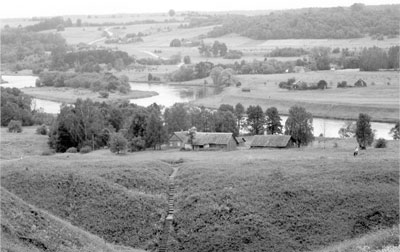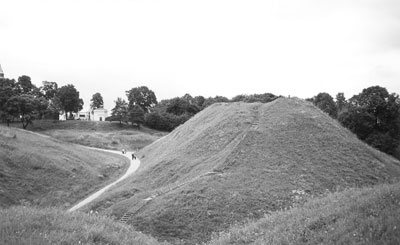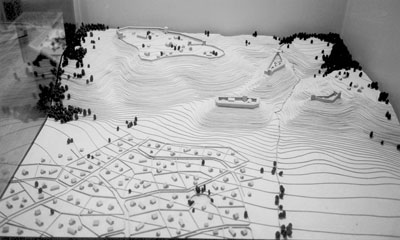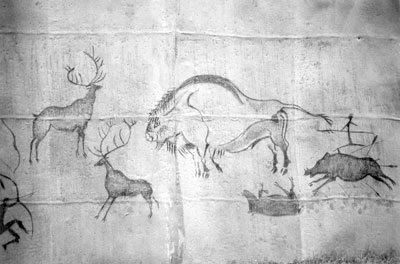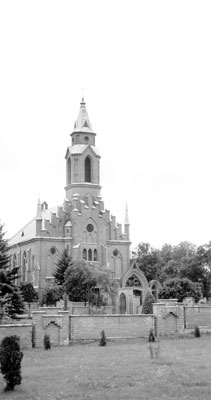Kernave: Lithuania’s royal mounds
On my most recent trip to Lithuania, in June-July ’03, I went to celebrate a coronation that took place 750 years before. Mindaugas, honored as the founder of the Lithuanian state and the unifier of its many tribal groups, was crowned king in 1253. He was the only Lithuanian ruler ever to bear this title. Mindaugas’ reign as king was brief, a mere 10 years, during which he repelled the Tartars invading from the south and the Teutonic knights from the west. In 1263 he was assassinated. He was 44 years old.
Among the events planned to commemorate the anniversary of Mindaugas’ coronation were the opening of a new bridge named after him, across the Neris River in Vilnius’ Old Town, and the unveiling of his statue in front of the National Museum, a few steps from the Cathedral in the Old Town. I wanted to be there for both celebrations, which, happily, coincided with Lithuania’s grand Song and Dance Festival held every four to five years.
I also wanted to revisit Kernave, Lithuania’s most important archaeological site, located 20 miles northwest of the capital of Vilnius.
It is almost certain that Mindaugas was not crowned at Kernave. That probably occurred at Novogrudok (Naugardukas, in Lithuanian) in present-day Belarus, Lithuania’s neighbor to the southeast. But Kernave may have been the site of Mindaugas’ capital, called Voruta in the Livonian Rhymed Chronicles.
The area where Kernave is located is beautiful. From an upper terrace on which the present-day modern village is located, there is a panoramic view over the entire archaeological site. Below flows the winding Neris River through the lush, green Pajauta Valley. Dominating the landscape are mounds of varying heights.
Prehistory
The ice age that ended 12,000 years ago carved out steep hills and valleys at Kernave. Probably by about 7000-6000 B.C. the first people appeared, pitching their tents beside the Neris and gathering, fishing and hunting, especially the abundant reindeer. Some of the tools they used have been found here: arrowheads, scrapers and cleavers.
More permanent settlement occurred some two to three thousand years later with the arrival of settlers who began to farm the land.
By about A.D. 500, because of frequent attacks, the valley dwellers relocated to the greater protection of the mounds nearby. At about this time, Kernave may have become one of the important tribal centers of eastern Lithuania — together with Vilnius and Trakai — from which the Lithuanian state later sprang.
Around A.D. 800, settlements once again began to develop in the Pajauta Valley at the foot of the mounds. Between 1100 and 1300 there was a sizeable trading center of three to four thousand inhabitants with fortified settlements and castle-fortresses on the mounds nearby. By Mindaugas’ time, the mid-13th century, Kernave was an important feudal center and, possibly, the capital of a more-or-less unified Lithuanian people.
Not for long, unfortunately. The Teutonic knights attacked in 1365 and again in 1390. After the last attack, the destroyed castle-fortresses on top of the mounds were never rebuilt and the town in the valley was never resettled.
Kernave today
What’s left today of those brief days of glory? Four mounds plus hundreds of artifacts recovered from them.
The oldest mound is the one directly ahead from the observation platform on the upper terrace. Called Aukuro Kalnas, or Hearth Mound, it was probably the first of the mounds to be settled.
Legend has it that a pagan temple once stood here with a sacred fire tended by a pagan priest named Lizdeika, who supposedly sought refuge here from the growing number of Christians. (Lithuania was one of the last countries in Europe to accept and adopt Christianity and that only in the 13th century with the baptism of Mindaugas in 1250.) If Mindaugas had a castle at Kernave, it would probably have stood here.
To the left of Hearth Mound is Mindaugo Sosto, or Mindaugas’ Throne, so called because legend says that he was crowned here. Probably there was once a fortress, serving to protect Hearth Mound.
Just beyond Mindaugas’ Throne to the left lies Lizdeikos Piliakalnis, Lizdeika Castle Mound, the mound with the steepest sides (99 feet on the side facing the Neris River) and the smallest flat summit area (40 feet by 89 feet). Lizdeika Mound, like Mindaugas’ Throne, probably had a small fortress to protect it from attacks from the east.
To the right of Hearth Mound is Piliakalnis, or Castle Mound, the largest of the mounds. In the Middle Ages it was densely populated with merchants and craftsmen who lived and worked here.
In 1989 the Kernave Archaeological Reserve was established to protect the mounds and the surrounding area. Excavations have been ongoing in the area where the medieval town in the valley once stood.
Museum
There is an excellent small museum nearby with a model of what Kernave must have looked like 750 years ago. A sampling of the hundreds of artifacts found on-site is also displayed, arranged according to era, beginning with the post ice age right up to the 20th century. The museum is open from 10 to 3, Wednesday to Sunday, November to March, and from 10 to 5, Wednesday to Sunday, April to October.
Touring the mounds is easy on one’s own, although you probably will need to rent a car to get from Vilnius to Kernave, a drive of about an hour. Kernave is located west of the main highway between Vilnius and Panevezys. The museum sells a good booklet describing the site and detailing its history: “Kernave: a Guide” by J. Vitkunas.
If you go. . .
On this trip, I divided my two weeks in Vilnius between the Mabre Residence Hotel and the Shakespeare Hotel.
I’ve stayed at the Mabre on two previous trips to Lithuania. Located at the edge of the Old Town at Maironio 13, the Mabre is housed in an old Russian Orthodox monastery with a lovely interior courtyard. Rates for a double start at 430 litas, about $143. The Mabre’s e-mail address is mabre@mabre.lt.
The Shakespeare Hotel is one of Vilnius’ newest hotels. It’s located in the Old Town at Bernardinu 8 in a beautifully renovated old building, and its rooms are named after famous writers (Charles Dickens, Ernest Hemingway and Fyodor Dostoevsky, among others). We stayed in the tastefully furnished Shakespeare Room complete with volumes of the Bard’s plays and sonnets. The hotel has a wonderful English-style club room with cushy sofas, a bar and lots of books for browsing. Rates start at 560 litas, about $187, for a double. Their e-mail address is info@shakespeare.lt.
As for restaurants, there are many good ones that have appeared in the dozen years since Lithuania regained its independence. A few of our favorites are El Gaucho Sano, at Pilies 10, for Argentinian steaks; Stikliai, in the Stikliai Hotel at Gaono 7, for superb French food; Rossini, in the City Park Hotel at Stuokos-Guceviciaus 1, for Italian dining, and Ritos Smukle, at Zirmunu 68 (a 10-minute cab ride from the Old Town), for some of the best authentic Lithuanian cooking outside my mother’s kitchen.
We flew SAS from Newark to Vilnius with a change of plane in Copenhagen.
There are a number of good travel guides published for Vilnius, including “Guide to Vilnius” by Joseph Everatt (2001, Garnelis Publishing, Vilnius. ISBN 9955-428-15-5) and Vilnius in Your Pocket, published six times a year and available in bookstores and hotels in Vilnius. There’s also “Estonia, Latvia & Lithuania” by John Noble (1997, Lonely Planet, Oakland, California. ISBN 0-86442-416-7), part of an excellent and extensive series. Lonely Planet also publishes a pocket-sized phrase book for the Baltic States for those travelers who would like to learn a few essential words to use on their trips.

